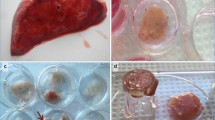Abstract
Proliferation and differentiation of epithelial cells are thought to be regulated by soluble factors in extracellular fluid and insoluble components of the extracellular matrix. We have examined the combined effects of soluble factors and an extracellular matrix (EHS matrix) on DNA synthesis, cell proliferation, and surfactant protein gene expression in primary cultures of alveolar type II epithelial cells. Cells on EHS matrix cultured in DMEM containing insulin, cholera toxin, EGF, aFGF, 5% rat serum, and 15-fold concentrated bronchoalveolar lavage fluid (D-GM) formed larger aggregates than cells cultured on the same substratum in DMEM containing 5% rat serum (D-5). Cells cultured in D-GM on EHS matrix incorporated more [3H]-thymidine than cells on the same substratum in D-5, with an eight-fold increase seen on day 4 of culture. This increase in [3H]-thymidine incorporation was accompanied by a labeling index of greater than 65% of the cells. Cell counts showed that exposure of type II cells on EHS matrix to D-GM resulted in increased cell number on day 4 of culture. [3H]-thymidine autoradiography combined with immunostaining with anti-cytokeratin, anti-SP-A, and anti-vimentin antibodies demonstrated that the proliferating cells were epithelial cells that contained SP-A. Type II cells cultured on plastic in D-GM also showed increased [3H]-thymidine incorporation compared to cells cultured in D-5. The level of [3H]-thymidine incorporation by cells on plastic, however, was significantly less than that seen in cells cultured in the same medium on EHS matrix. Type II cells cultured on EHS matrix in D-GM had a decreased abundance of mRNAs for SP-A and SP-C than cells cultured on EHS matrix in D-5 as determined by Northern analysis. This inhibition was reversed by switching from D-GM to D-5 on day 4 and culturing the cells for an additional 4 days. In contrast, SP-B mRNA was increased in response to D-GM. This increase was not reversed by switching from D-GM to D-5 on day 4. These results suggest that the interaction of soluble factors and extracellular matrix components has a strong influence on type II cell proliferation, which were partially associated with the reversible inhibition of lung tissue-specific protein mRNAs. Their dynamic interplay among the type II cell, the extracellular matrix, and growth factors may determine multicellular functions and play an important role in normal lung development and in the repair of the lung epithelium following injury.
Similar content being viewed by others
Author information
Authors and Affiliations
Additional information
Received: 4 March 1997 / Accepted: 17 July 1997
Rights and permissions
About this article
Cite this article
Sugahara, K., Mason, R. & Shannon, J. Effects of soluble factors and extracellular matrix on DNA synthesis and surfactant gene expression in primary cultures of rat alveolar type II cells. Cell Tissue Res 291, 295–303 (1998). https://doi.org/10.1007/s004410050999
Issue Date:
DOI: https://doi.org/10.1007/s004410050999




